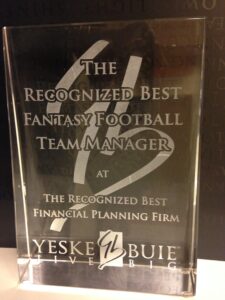Investing Lessons from Fantasy Football


It is estimated that over 50 million Americans played fantasy football last season, with projections for this year’s season to be even more popular. If you aren’t playing in a fantasy football league this year (and the odds are if you’re playing in one, you’re probably playing in multiple leagues), then you almost certainly know someone who is playing. The Yeske Buie Team is more than halfway through an exciting season, and Partner Lauren Stansell is currently leading the pack with a record of 7-2.
In addition to being a source of fun and team bonding for our team (the league has a history of being competitive, especially with the addition of a trophy for the winner and a different kind of “prize” for the loser introduced in 2015 – more on that later), there are a number of investing lessons that you can take away from engaging with this game. In this space, we’ll share a brief overview of the game for those who are less familiar, give you an inside look into some of our nerdy shenanigans, and draw three connections between investing and fantasy football. We hope you enjoy!
A Brief Overview of Fantasy Football
Fantasy football has been around since 1963 when Wilfred Winkenbach, a limited partner in the Oakland Raiders, founded the Greater Oakland Professional Pigskin Prognosticators League. The game really took off, however, in the late 1990s; all major sports media websites began offering competing versions of the game by the start of the 21st century.
A typical fantasy football roster has 16 slots, and leagues range in size from 8 to 12 teams. Each team’s manager names 9 players as starters each week and competes against their opponent’s starting lineup; each team’s respective players’ statistics are compiled to determine the team’s aggregate weekly score. The remaining 7 players on each roster sit on the bench, and their stats do not count toward the team’s score. It is the manager’s job to determine who should start or sit each week. Standard fantasy league rules stipulate that starting lineups are configured as follows:
-
-
-
- 1 Quarterback
- 2 Running Backs
- 2 Wide Receivers
- 1 Tight End
-
-
- 1 Defense/Special Teams
- 1 Kicker
- 1 Flex Player (can be a Running Back, Wide Receiver, or Tight End, depending on league rules
An Inside Look at Yeske Buie’s Nerdy Financial Planning Team
Client Support Specialist, Will Tracy, has been serving as the league’s commissioner and unofficial sportscaster with a weekly email to the team recapping the previous week’s match-ups and the best and worst decisions by managers each week.
In addition to some internal shenanigans, these emails have surfaced several references to financial planning and investing behaviors…
- In Week 2, Will came up short in his game against Yusuf, in part because he left Seattle Seahawks wide receiver, Tyler Lockett, in his lineup and Lockett ended up not playing (he was listed as a game time decision). This left Will with zero points in that position. Reflecting on his mistake, Will sarcastically said, “Yusuf, I wanted to use my annual gift tax exclusion for you this year so I purposely decided to play an inactive player and leave Lockett on my bench.”
- Following a wild performance by Minnesota Viking’s wide receiver, Jordan Addison, in Week 7, Lauren Stansell said: “Watching my win probability felt like watching stocks or cryptocurrencies! I had a 9% chance of winning at the start of Monday Night Football, was down to 1% about five minutes into the game, and yet I won!”
What do these quotes say about us? Hopefully that we’re really passionate about what we do!
Connections Between Fantasy Football and Investing
Even when having fun, it’s natural for me to draw connections between the entertainment I’m consuming and the work we do for our Clients. Consider these connections between serving as a fantasy football team manager and Yeske Buie’s investment philosophy:
- Don’t Overvalue Glamour: Just as a diversified portfolio may include some glamour stocks (i.e. stocks trading at valuations higher than the average) as a part of a broad market index, a functional fantasy football team must have a quarterback. Quarterback is the most highly paid position in the NFL, but that doesn’t directly correspond to their priority regarding fantasy draft status; just because something is expensive doesn’t mean it’s commensurately valuable.
- Don’t Undervalue Low-Cost Investments: Research shows that, over the long run, value stocks (i.e. stocks trading at valuations lower than average) tend to outperform glamour stocks, and Yeske Buie’s portfolios are designed to capitalize on that. Similarly, a good fantasy football manager looks to add undervalued players (rookies or players new to their roles) to his/her roster with the aim of “buying low and selling high”.
- External Factors Matter: Just as the markets can be influenced by geo-political considerations, non-football factors must be taken into account when configuring one’s starting lineup. A good manager must consider the weather in which the player will be competing, as well as nuances like distance traveled (ex. players from West Coast teams are notorious for performing poorly in early afternoon games on the East Coast, as their body clocks are still adjusting to the time difference). Of course, in the end, no matter how much one may try to manage these external factors, the results are driven more by random chance than anything else.
In some years, my approach to managing my fantasy football team is similar to that of an active investment manager trying to pick “hot stocks” (an approach that has consistently failed to beat the market over time) constantly churning the roster and looking to capitalize on a hot tip. While doing so in a fantasy environment can be justified because, in my opinion, “the potential benefits outweigh the costs because there are no costs,” I must nonetheless observe that, while I finished first in 2014, I came in dead last in 2013. An example, we think, of the relative importance of skill versus random chance. And, of course, when it comes to real-life investing, costs matter and trying to beat the market is an expensive enterprise. The best approach to investing accounts for the aforementioned “lessons,” and is one with which Yeske Buie’s Clients have grown familiar: diversify amongst and across asset classes, control costs, and rebalance in a disciplined fashion.


